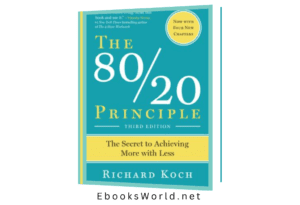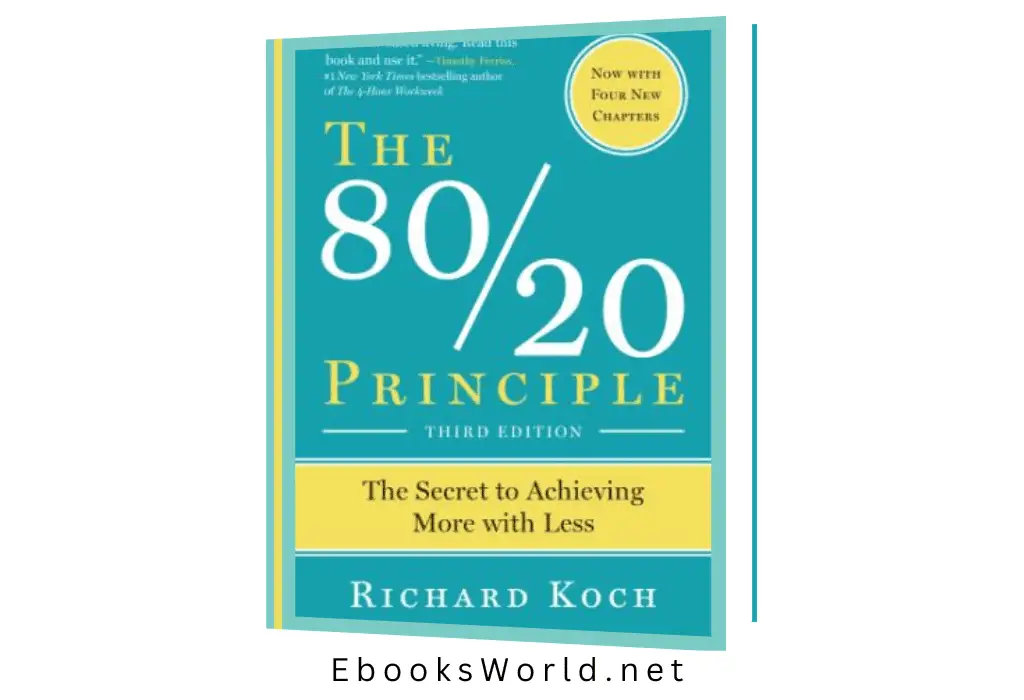The 80/20 Principle: The Secret to Achieving More with Less

“The 80/20 Principle: The Secret to Achieving More with Less” by Richard Koch is a groundbreaking book that explores the Pareto Principle, a concept that suggests that roughly 80% of effects come from 20% of causes. Koch extends this principle to various aspects of life, from business to personal development, and demonstrates how understanding and applying the 80/20 principle can lead to increased efficiency, productivity, and overall success.
Introduction:
The book begins by introducing the 80/20 Principle, also known as the Pareto Principle, named after the Italian economist Vilfredo Pareto. Pareto observed that 80% of Italy’s wealth was owned by 20% of the population. Richard Koch takes this principle and applies it to a wide range of fields, arguing that a small percentage of efforts or inputs often lead to the majority of outcomes.
Chapter 1: The 80/20 Principle and Its Impact
Koch delves into the history of the 80/20 Principle, emphasizing its ubiquity in various aspects of life. He discusses how this principle is a powerful tool for understanding and improving efficiency, effectiveness, and overall results.
Chapter 2: The Law of the Vital Few
This chapter explores the core concept of the 80/20 Principle, where a small fraction of inputs (the vital few) leads to the majority of outputs. Koch illustrates this with real-world examples, emphasizing the uneven distribution of results in business, relationships, and time management.
Chapter 3: Thinking 80/20
Koch encourages readers to adopt an 80/20 mindset, which involves focusing on the most critical tasks and inputs that drive the greatest impact. By identifying and concentrating on the vital few, individuals and organizations can achieve more with less effort.
Chapter 4: The 80/20 Principle and Time Management
Koch applies the 80/20 Principle to time management, suggesting that a small percentage of tasks contribute significantly to overall productivity. By prioritizing and focusing on high-impact activities, individuals can optimize their use of time.
Chapter 5: The 80/20 Principle and Business
The author explores how the 80/20 Principle applies to business, highlighting the uneven distribution of profits, customers, and products. Koch suggests that businesses can achieve remarkable improvements by identifying and concentrating efforts on the most profitable and impactful elements.
Chapter 6: The 80/20 Principle and Decision Making
Koch discusses how the 80/20 Principle can guide decision-making. By identifying the most influential factors and concentrating efforts on those, individuals can make better decisions with far-reaching consequences.
Chapter 7: The 80/20 Principle and Relationships
This chapter explores the application of the 80/20 Principle to relationships. Koch suggests that a small percentage of people and activities contribute significantly to personal happiness and satisfaction. Focusing on these vital few relationships can lead to a more fulfilling life.
Chapter 8: The 80/20 Principle and Health
Koch extends the application of the 80/20 Principle to health, emphasizing that a small number of lifestyle changes can have a profound impact on well-being. By identifying and focusing on the most critical health factors, individuals can optimize their overall health.
Chapter 9: The 80/20 Principle and Happiness
The author explores the connection between the 80/20 Principle and happiness. By concentrating on the few activities and relationships that bring the most joy and fulfillment, individuals can lead more satisfying lives.
Chapter 10: The 80/20 Principle and Money
Koch applies the 80/20 Principle to financial management, suggesting that a small percentage of investments, clients, or products often contribute disproportionately to financial success. By identifying and maximizing these vital few elements, individuals can enhance their financial well-being.
Chapter 11: The 80/20 Principle and Simplification
Koch advocates for simplification by focusing on the essential few and eliminating or minimizing the trivial many. This chapter provides practical strategies for simplifying various aspects of life, leading to increased efficiency and clarity.
Chapter 12: The 80/20 Principle and Complexity
The author discusses the paradox of complexity, where simplicity often leads to greater effectiveness. Koch encourages readers to identify and prioritize the critical few elements that drive success, avoiding unnecessary complexity.
Chapter 13: The 80/20 Principle and Excellence
Koch explores how the 80/20 Principle can be applied to achieve excellence in various areas. By concentrating efforts on the vital few factors that lead to superior performance, individuals and organizations can stand out in their fields.
Chapter 14: Living the 80/20 Way
The book concludes with a guide on how to incorporate the 80/20 Principle into everyday life. Koch provides practical tips and strategies for applying the principle across different domains, emphasizing the transformative impact it can have on one’s life.
Conclusion:
“The 80/20 Principle” by Richard Koch is a thought-provoking exploration of a simple yet powerful concept. By understanding and applying the 80/20 Principle, individuals can achieve more with less, optimize their time and efforts, and ultimately lead more fulfilling and successful lives. The book serves as a guide for readers to adopt an 80/20 mindset and apply this principle across various aspects of their personal and professional endeavors.







